Limehouse
| Limehouse | |
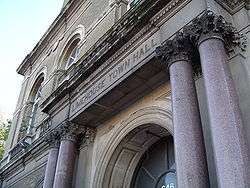 Limehouse Town Hall on Commercial Road, built in 1878 for the Limehouse District |
|
 Limehouse |
|
| Population | 15,986 (2011 Census.Ward)[1] |
|---|---|
| OS grid reference | TQ365815 |
| London borough | Tower Hamlets |
| Ceremonial county | Greater London |
| Region | London |
| Country | England |
| Sovereign state | United Kingdom |
| Post town | LONDON |
| Postcode district | E14 |
| Dialling code | 020 |
| Police | Metropolitan |
| Fire | London |
| Ambulance | London |
| EU Parliament | London |
| UK Parliament | Poplar and Limehouse |
| London Assembly | City and East |
Coordinates: 51°30′57″N 0°01′54″W / 51.5158°N 0.0318°W
Limehouse is a district in east London, England, in the London Borough of Tower Hamlets. Located 3.9 miles (6.3 km) east of Charing Cross, It is on the northern bank of the River Thames opposite Rotherhithe and between Ratcliff to the west and Millwall to the east.
Limehouse stretches from Limehouse Basin in the west to the edge of the former Chinatown in Pennyfields in the east; and from the Thames in the south to the Victory Bridge at the junction of Ben Jonson Road and Rhodeswell Road in the north.
The area gives its name to Limehouse Reach, a section of the Thames which runs south to Millwall after making a right-angled bend at Cuckold's Point, Rotherhithe. The west-to-east section upstream of Cuckold's Point is properly called the Lower Pool.[2]
History
Etymology


The name relates to the local lime kilns or, more precisely, lime oasts, by the river and operated by the large potteries that served shipping in the London Docks. The name is from Old English līm-āst "lime-oast". The earliest reference is to Les Lymhostes, in 1356.[3]
The name 'Limehouse' is sometimes mistakenly thought to be derived from the nickname for the seamen that disembarked there, who had earned the name Lime-juicers or limeys after the obligatory ration of lime juice the Royal Navy gave their sailors to ward off scurvy.
The name is found used in 1417:
Inquisicio capta sup' litus Thomisie apud Lymhosteys pro morte Thome Frank.
("Inquest held on the shore of the Thames by Lymhosteys for the death of Thomas Frank")
17 Aug, 5 Henry V. [A.D. 1417], inquest held before "les Lymehostes" within the liberty and franchise of the City, before Henry Bartone, the Mayor, and the King's Escheator, as to the cause of the death of Thomas Franke, of Herewich, late steersman (conductor) or "lodysman" of a ship called "la Mary Knyght" of Danzsk in Prussia. A jury sworn, viz., John Baille, Matthew Holme, Robert Marle, Henry Mark, Alexander Bryan, John Goby, Richard Hervy, Walter Steel, Peter West, Richard Stowell, John Dyse, and Walter Broun. They find that the said Thomas Franke was killed by falling on the sharp end of an anchor
Maritime links
From its foundation, Limehouse, like neighbouring Wapping, has enjoyed better links with the river than the land, the land route being across a marsh. Limehouse became a significant port in late medieval times, with extensive docks and wharves. Although most cargoes were discharged in the Pool of London before the establishment of the docks, industries such as shipbuilding, ship chandlering and rope making were established in Limehouse.
Limehouse Basin opened in 1820 as the Regent's Canal Dock. This was an important connection between the Thames and the canal system, where cargoes could be transferred from larger ships to the shallow-draught canal boats. This mix of vessels can still be seen in the Basin: canal narrowboats rubbing shoulders with seagoing yachts.[4]
From the Tudor era until the 20th century, ships crews were employed on a casual basis. New and replacement crews would be found wherever they were available - foreign sailors in their own waters being particularly prized for their knowledge of currents and hazards in ports around the world. Crews would be paid off at the end of their voyages and, inevitably, permanent communities of foreign sailors became established, including colonies of Lascars and Africans from the Guinea Coast. Large Chinese communities at both Limehouse and Shadwell developed, established by the crews of merchantmen in the opium and tea trades, particularly Han Chinese. The area achieved notoriety for opium dens in the late 19th century, often featured in pulp fiction works by Sax Rohmer and others. Like much of the East End it remained a focus for immigration, but after the devastation of the Second World War many of the Chinese community relocated to Soho.[5][6]
On 12 February 1832, the first case of cholera was reported in London at Limehouse. First described in India in 1817, it had spread here via Hamburg. Although 800 people died during this epidemic, fewer than had died of tuberculosis in the same year, cholera visited again in 1848 and 1858.[7]
The use of Limehouse Basin as a major distribution hub declined with the growth of the railways, although the revival of canal traffic during World War I and World War II gave it a brief swansong. Today, Stepney Historical Trust works to advance the public's education in the history of the area.
Modern Limehouse
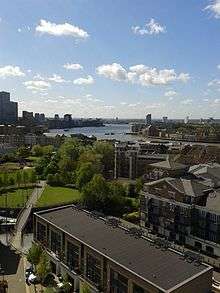
Limehouse Basin was amongst the first docks to close in the late 1960s. By 1981, Limehouse shared the docklands-wide physical, social and economic decline which led to the setting up of the London Docklands Development Corporation. In November 1982, the LDDC published its Limehouse Area Development Strategy.[8] This built on existing plans for Limehouse Basin, and offered a discussion framework for future development, housing refurbishment and environmental improvements across the whole of Limehouse. It was based on four major projects: Limehouse Basin, Free Trade Wharf, what was then known as the Light Rapid Transit Route (DLR) and the Docklands Northern Relief Road, a road corridor between The Highway and East India Dock across the north of the Isle of Dogs.
However, it was not until the mid-1980s with the abolition of the Greater London Council that the impetus for improvements to the infrastructure was provided. The key to development in Limehouse lay next door in the Isle of Dogs. Initial development plans on the island had been modest: light industrial development and a low rise business park. The Limehouse Studios were an early development on the island; despite the name the studios were located in South Quay, not Limehouse.
By 1984, 8 million sq it of potential commercial development was predicted. In 1985 proposals for a 10-12 million sq it development on the 71 acres (290,000 m2) of Canary Wharf were being considered. The sheer scale of the Canary Wharf proposals, and in due course the rapid implementation of the first phase of development, provided the impetus to the transport improvements which completely altered prospects for Limehouse as well as for the Isle of Dogs.The derelict Regent's Canal Dock was converted into Limehouse Marina.
Significant events in politics

On 30 July 1909, the Chancellor of the Exchequer David Lloyd George made a polemical speech in Limehouse attacking the House of Lords for its opposition to his "People's Budget" and speaking of the Budget's social aims. This was the origin of the verb 'to Limehouse', "To make fiery (political) speeches such as Mr. Lloyd George made at Limehouse in 1909".[9]
From 1906 to 1909, Clement Attlee worked as manager of Haileybury House, a club for working class boys in Limehouse run by his old school. Before this, Attlee's political views had been conservative, but he was shocked by the poverty and deprivation he saw while working with slum children, and this caused him to become a socialist. He joined the Independent Labour Party in 1908, and became mayor of Stepney in 1919. At the 1922 general election, Attlee became MP for the constituency of Limehouse, which he represented while Deputy Prime Minister. After WWII he moved constituencies to Walthamstow West.[10]
On 25 January 1981, MPs Shirley Williams, Roy Jenkins, William Rodgers and David Owen made the Limehouse Declaration from Owen's house in Limehouse, which announced the formation of the Council for Social Democracy in opposition to the granting of block votes to the trade unions in the Labour Party to which they had previously belonged. They soon became leading politicians in the Social Democratic Party.
Today, Limehouse is part of the constituency of Poplar and Limehouse and has been represented in the House of Commons since 1997 by Jim Fitzpatrick MP (Labour), and in the London Assembly since 2016 by Unmesh Desai AM (also Labour).
Cultural references
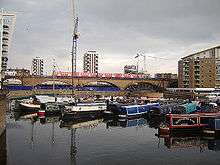
The area inspired Douglas Furber (lyricist) and Philip Braham (composer) in 1921 to write the popular jazz standard "Limehouse Blues",[11] which was introduced by Jack Buchanan and Gertrude Lawrence in the musical revue "A to Z". Much later, it was reprised in the ballet "Limehouse Blues" featuring Fred Astaire and Lucille Bremer in the musical film Ziegfeld Follies (1946) and by Julie Andrews in Star!(1968). In both instances the actors were heavily disguised as Chinese. Other notable performances on film include those by Hoagy Carmichael in To Have and Have Not (1946) and by Borrah Minevich and His Harmonica Rascals in One in a Million (1936). Limehouse Blues was also the name of a 1934 film, starring George Raft.[12]
Thomas Burke wrote Limehouse Nights (1916), a collection of stories centred around life in the poverty-stricken Limehouse district of London. Many of Burke's books feature the Chinese character Quong Lee as narrator. The area also features in the Fu Manchu books of Sax Rohmer, where a Limehouse opium den serves as the hideout of the Chinese supervillain. The notion of East End opium dens seems to have originated with a description by Charles Dickens of a visit he made to an opium den in nearby Bluegate Fields, which inspired certain scenes in his last, unfinished, novel The Mystery of Edwin Drood (1870).[13][14] More recently, the popular graphic novels of Alan Moore, "From Hell" (1989) and "The League of Extraordinary Gentlemen" (1999) contain a number of references to the notorious criminality of the area in Victorian London. Victorian-era Limehouse was also the setting of the novel Dan Leno and the Limehouse Golem (1995) by Peter Ackroyd, a fictionalized account of the notorious 'Limehouse Golem' serial murders.[15]
The area also appeared in Anna Mae Wong's 1929 film Piccadilly, where, as the toughly alluring Shosho, Wong was said to embody the Limehouse Chinatown mystique. The Limehouse district of London is depicted in the silent film "Broken Blossoms" or "The Yellow Man And The Girl" directed by "D.W. Griffith" (1919) "where the Orient squats at the portals of the West." Limehouse is also the setting of the 1926 film "The Blackbird," directed by Tod Browning and starring Lon Chaney.
Birthplace of the rock group Limehouse Lizzy [16]
Notable residents

Sir Humphrey Gilbert lived here,[17] and was an advocate of opening up the Northwest Passage. This inspired Martin Frobisher to sail to Baffin Island, and he returned with a mysterious black rock.[18] Gilbert set up the Society of the New Art with Lord Burghley and the Earl of Leicester, who had their alchemical laboratory in Limehouse;[19] however, their attempts to transmute the black rock into gold proved fruitless. (Humphrey's brother Adrian Gilbert was reputed a great alchemist and worked closely with John Dee.)
Captain Christopher Newport lived in Limehouse for several years up until 1595.[20] He rose through the sailing ranks from a poor cabin boy to a wealthy English privateer and eventually one of the Masters of the Royal Navy. He became rich pirating Spanish treasure vessels in the West Indies. In 1607 he sailed the Susan Constant, followed by the Godspeed and Discovery, as Admiral of the Fleet to Jamestown. He helped secure England's foothold in North America through five voyages to Jamestown. He sailed his entire life, dying on a trading voyage to Bantam, on the island of Java in present-day Indonesia. His sailing experience in Limehouse made him known as Captain Christopher Newport, of Limehouse, Mariner.
Charles Dickens' godfather, Christopher Huffam,[21] ran his sailmaking business from 12 Church Row (Newell Street).[22] Huffam is said to be the inspiration for the Paul Dombey character in Dickens' Dombey and Son.
James McNeill Whistler[23] and Charles Napier Hemy[24] sketched and painted at locations on Narrow Street's river waterfront.
Contemporary residents include the actor Sir Ian McKellen,[25] Matthew Parris,[26] and comedy actress Cleo Rocos,[27] actor Steven Berkoff,[28] comedian Lee Hurst , as well as politician Lord David Owen.[29]
Limehouse was also the home of the late film director Sir David Lean.[30] His home on Narrow Street is still owned by his family.
Buildings
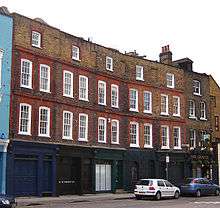
St Anne's Limehouse was built by Nicholas Hawksmoor. A pyramid originally planned to be put atop the tower now stands in the graveyard. The church is next door to Limehouse Town Hall and close to Limehouse Library, both Grade II listed buildings, the former now used as a community centre. Across the road is the Sailors' Mission, where Situationist International held its conference in 1960. The building subsequently became a run-down hostel for the homeless which became notorious for its squalor, although it has since been converted into a luxury apartment block.
Further to the southwest, Narrow Street, Limehouse's historic spine, which runs along the back of the Thames wharves, boasts one of the few surviving early Georgian terraces in London. Next to the terrace is the historic Grapes pub, rebuilt in 1720 and well-known to Charles Dickens, featuring as the Six Jolly Fellowship Porters in Our Mutual Friend. A few doors along was Booty's Riverside Bar but this closed down in 2012. Almost every building on the other side of Narrow Street was destroyed by bombing in the Second World War, including hundreds of houses, Taylor Walker & Co's Barley Mow Brewery and a school. One notable exception is a former public house, known locally as 'The House They Left Behind', because it was the only Victorian terrace to survive. It still stands today, with the aid of three large supporting pillars.
Further along the street is 'The Narrow', a gastropub, now run by Gordon Ramsay. It is housed in the Grade II listed, former dockmaster's and Customs House, for Limehouse Dock.[31]
Education
Transport
Rail
The nearest station is Limehouse station for Docklands Light Railway and c2c and Westferry for Docklands Light Railway.
Buses
15, 115, 135, 277, D3, D6, D7, N15, N550, N551 all operate within the area.
Roads, cycling, walking
Limehouse is connected to the National Road Network by the A13 Commercial Road which passes west-east through Limehouse, while the A1203 Limehouse Link tunnel passes under Limehouse Basin, linking The Highway with the Docklands Northern Relief Road. The northern entrance of the Rotherhithe Tunnel emerges in Limehouse, to the west of the Basin and close to Limehouse railway station.
Narrow Street forms a part of the north bank of the Thames Path and Cycle Superhighway CS3, the walk and cycle lane is between tall former warehouses and modern flats. Many were built with planning covenants granting river access, but these are now often barred to the public. Vehicular access is limited, as the area is cut off by the entrance to the Limehouse tunnel and parking is strictly controlled, however this makes the area reasonably quiet for cyclists. Public access to the foreshore is prohibited, apparently part of the security arrangements for former Foreign Secretary, David Owen. The National Cycle Route 1 also runs in Limehouse north and south.
Waterways
Though no longer a working dock, Limehouse Basin basin with its marina remains a working facility. The same is not true of the wharf buildings that have survived, most of which are now highly desirable residential properties. Limehouse Basin connects to the Regent's Canal via the Commercial Road Lock to the north, and the River Thames via Limehouse Basin Lock to the south. The Limehouse Cut connects the Basin to the River Lea in the east.
Gallery
| Wikimedia Commons has media related to Limehouse. |
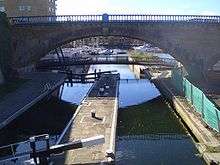
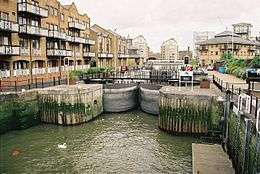
 Construction of apartments on Commercial Road (now complete).
Construction of apartments on Commercial Road (now complete). Taken from Narrow Street, this shows the proximity of Limehouse to four of the high rise buildings of Canary Wharf.
Taken from Narrow Street, this shows the proximity of Limehouse to four of the high rise buildings of Canary Wharf. The Mission, formerly the British Sailors Society, now apartments.
The Mission, formerly the British Sailors Society, now apartments.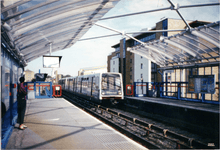 A picture of Limehouse D.L.R. station in 2002.
A picture of Limehouse D.L.R. station in 2002.
References
- ↑ "Tower Hamlets Ward population 2011". Neighbourhood Statistics. Office for National Statistics. Retrieved 17 October 2016.
- ↑ Port of London Authority Map of the River Thames, Lower Pool to Limehouse Reach (October 2013 -- January 2014); Chandler, The New Seaman's Guide and Coaster's Companion; Henry Wheatley, London Past and Present, 362; Norie, New and Extensive Sailing Directions for the Navigation of the North Sea. It can be seen clearly in Stanford's Library Map of London 1872 vs. accessed 27.4.2015.
- ↑ Folios cxci - cc: Dec 1416 - ', Calendar of letter-books of the city of London: I: 1400-1422 (1909), pp. 175-86
- ↑ Regent's Canal Dock (1812–1970s) accessed 10 May 2007
- ↑ Port Cities: London's First Chinatown accessed 29 May 2007
- ↑ 'Chinatown' literature accessed 10 May 2007
- ↑ The 1832 cholera epidemic in East London East London Record, 2 (1979) accessed 5 July 2007
- ↑ , LDDC Completion Booklet.
- ↑ Oxford English Dictionary, "Limehouse".
- ↑ Beckett, Francis. (1997) Clem Attlee: A Biography Francis Beckett (Richard Cohen Books) ISBN 1-86066-101-7
- ↑ Limehouse Blues sheet music and sample files accessed 10 May 2007
- ↑ Limehouse Blues at the Internet Movie Database
- ↑ Peter Ackroyd (1990) Dickens: 1046
- ↑ A Curious Burial 11 January 1890 East London Observer – an account of the burial of Ah Sing, said to be the inspiration for the character of the opium seller. Accessed 22 July 2008
- ↑ Ackroyd, Peter (1995). Dan Leno and the Limehouse Golem. Vintage. ISBN 0749396598.
- ↑ Limehouse Lizzy
- ↑ 1911 Encyclopaedia Britannica Sir Humphrey Gilbert accessed 10 May 2007
- ↑ 1911 Encyclopaedia Britannica Sir Martin Frobisher' accessed 10 May 2007
- ↑ Calendar of the Patent Rolls, Elizabeth I, Vol. VI, 1572-1575 Joel Hurstfield The English Historical Review, Vol. 91, No. 358 (Jan., 1976), pp. 127-129
- ↑ K.R. Andrews, Christopher Newport of Limehouse, Mariner, William and Mary Quarterly 3d ser., 11, no. 1(January 1954):28.
- ↑ West, Gilian. "Huffam and Son." Dickensian 95, no. 447 (Spring, 1999): 5-18.
- ↑ East London history accessed 28 March 2007
- ↑ Whistler Limehouse 1878 accessed 28 March 2007
- ↑ The Barge Builders in The Burlington Magazine, Vol. 126, No. 981 (Dec., 1984), p. 786+804
- ↑ Ian McKellen Personal Website
- ↑ http://www.telegraph.co.uk/culture/donotmigrate/3583637/Well-always-have-Parris.html
- ↑ The Wharf
- ↑ Steven Berkoff: The real East Enders The Independent 4 January 2007 accessed 10 May 2007
- ↑ David Owen biography accessed 28 March 2007
- ↑ The Independent
- ↑ Historic England. "Details from image database (441686)". Images of England. accessed 13 December 2008
